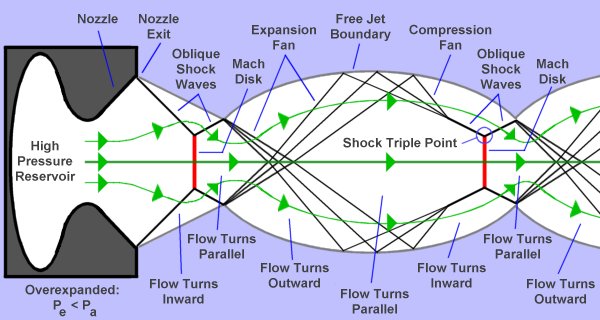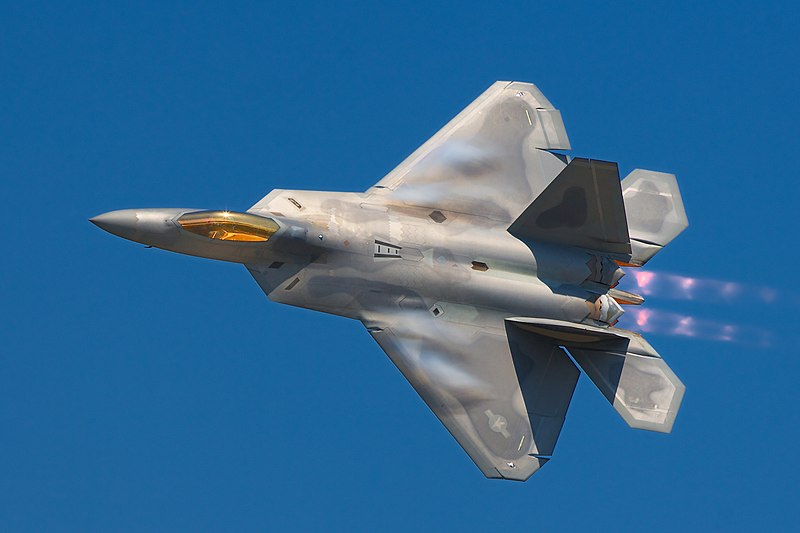Watch Shock Diamonds and Mach Disks Form In The Exhaust Plume Of An F-15E’s Engine

Shock Diamonds and Mach Disks in jet engines exhaust can be particularly evident and fascinating at night.
The video below shows RAF Lakenheath’s Propulsion Test Cell during a test of an F-15E Strike Eagle’s afterburning turbofan engine. The 4K footage is particularly interesting as it allows us to see, from close distance, the shock diamonds in the exhaust plume of the Pratt & Whitney F100.
In short, these shock diamonds are the visible effect of an abrupt change in local density and pressure in the exhaust. The exit pressure of the exhaust plume is lower than the atmospheric pressure. This is called an “overexpansion”. When a flow is overexpanded, the higher external atmosphere causes the lower pressure exhaust to compress. This compression increases the pressure of the exhaust that expands again gradually reducing the pressure again. Therefore, the flow contracts and expands until the pressure of the plume equalizes the atmospheric pressure.
A great description of how shock diamonds form and the theory behind it, can be found at the Aerospaceweb.org website.
Here’s an excerpt of the article by Jeff Scott posted there:

While exiting the nozzle, the flow near the centerline will be moving parallel to that centerline. However, the pressure of the ambient atmosphere beyond the free jet boundary is higher than that of the exhaust. This higher pressure forces the exhaust to turn inward towards the centerline. This turning is made possible through a type of wave called an oblique shock wave. Any shock wave causes a change in the pressure of a flow, an increase in this case. […]
On the other hand, a shock wave that is perpendicular to the direction of the flow is called a normal shock wave. A normal shock can be seen in the above diagram when the flow again turns parallel to the centerline. This normal shock creates a Mach disk in the exhaust flow. Passing through this normal shock wave causes the temperature of the flow to increase, igniting any excess fuel present in the exhaust making it burn. It is this burning fuel that makes the Mach disk glow and become visible to create the ring pattern.
Like the oblique shock, this normal shock wave also increases the pressure of the exhaust gases. However, the flow becomes so compressed that the pressure is now greater than that of the ambient atmosphere. As a result, the flow begins to turn outward and the exhaust expands as it tries to equalize with the external air. This turning of the flow is accomplished through a series of expansion waves that reflect off the free jet boundary and towards the centerline. These waves cause the flow to turn outward and reduce in pressure. The expansion waves then encounter their “twins” from the opposite side of the nozzle at the centerline and reflect back outward towards the free jet boundary, also called the contact discontinuity. As the flow passes through these reflected expansion waves, it is turned parallel to the centerline and again reduces in pressure. These two sets of expansion waves are collectively referred to as an expansion fan.
The expansion fan decreases the pressure of the exhaust, but it is now lower than the ambient pressure again. As the expansion waves reach the contact discontinuity, they again reflect back inward to create compression waves and a compression fan. These compression waves force the flow to turn back inward and increase in pressure. If the compression waves are strong enough, they will merge into an oblique shock wave and form a new Mach disk similar to that near the nozzle exit. This series of compression and shock waves increase the pressure above the external air causing a new expansion fan to form, and so on. This process repeats itself again and again to create the series of Mach disks that we recognize as shock diamonds in the exhaust of a jet or rocket engine.
Along with the Mach Disks the clip shows also the variable geometry of the nozzles, something I have already described in details here.
The theory behind the nozzles operations is simple: when the thrust increases, the nozzles open incrementally to adapt the exhaust section and accommodate the fuel enriched re-ignited gasses. If the nozzles did not open after selecting the afterburner, the high pressure and temperature could cause the turbine blades to overheat and fail.
Therefore, generally speaking:
- nozzles are open at rest, with the aircraft standing still at the parking slot
- when the aircraft is on the ground taxiing under idle thrust, the diameter section is decreased (the nozzles close)
- when afterburner is selected, the nozzles open
- when in flight, the nozzle position remains to minimum diameter until afterburner is selected
One last thing, the video shows a blue-colored plume. Although the color of the plume may depend on various factors, usually, the blue/purple flame color is typical of Russian engines. As explained in a previous article about the Tu-22M3 Backfire engines, when the color of the plume blue, there’s been a more complete combustion and the reaction has created enough energy to excite and ionize gas molecules in the flame, leading to a blue flame appearance. In other words the blue flame is produced by molecular radicals, especially CH and C2, which emit most of their light in the blue region of the visible spectrum. The orange color is instead caused by fuel not completely burned out before exiting the nozzle, thus creating soot (unburnt carbon particles) that glows in the heat of the flame giving the orange color.
David Cenciotti source
Shock diamond
Not to be confused with the mineral diamond.
Shock diamonds (also known as Mach diamonds or thrust diamonds) are a formation of standing wave patterns that appear in the supersonic exhaust plume of an aerospace propulsion system, such as a supersonic jet engine, rocket, ramjet, or scramjet, when it is operated in an atmosphere. The “diamonds” are actually a complex flow field made visible by abrupt changes in local density and pressure as the exhaust passes through a series of standing shock waves and expansion fans. Mach diamonds are named after Ernst Mach, the physicist who first described them.[1]: 48

Mechanism




Shock diamonds form when the supersonic exhaust from a propelling nozzle is slightly over-expanded, meaning that the static pressure of the gases exiting the nozzle is less than the ambient air pressure. The higher ambient pressure compresses the flow, and since the resulting pressure increase in the exhaust gas stream is adiabatic, a reduction in velocity causes its static temperature to be substantially increased.[2] The exhaust is generally over-expanded at low altitudes, where air pressure is higher.
As the flow exits the nozzle, ambient air pressure will compress the flow.[2] The external compression is caused by oblique shock waves inclined at an angle to the flow. The compressed flow is alternately expanded by Prandtl-Meyer expansion fans, and each “diamond” is formed by the pairing of an oblique shock with an expansion fan. When the compressed flow becomes parallel to the center line, a shock wave perpendicular to the flow forms, called a normal shock wave or Mach disk. This locates the first shock diamond, and the space between it and the nozzle is called the “zone of silence”.[3] The distance from the nozzle to the first shock diamond can be approximated by
where x is the distance, D0 is the nozzle diameter, P0 is flow pressure, and P1 is atmospheric pressure.[3]
As the exhaust passes through the normal shock wave, its temperature increases, igniting excess fuel and causing the glow that makes the shock diamonds visible.[2] The illuminated regions either appear as disks or diamonds, giving them their name.
Eventually the flow expands enough so that its pressure is again below ambient, at which point the expansion fan reflects from the contact discontinuity (the outer edge of the flow). The reflected waves, called the compression fan, cause the flow to compress.[2] If the compression fan is strong enough, another oblique shock wave will form, creating a second Mach disk and shock diamond. The pattern of disks and diamonds would repeat indefinitely if the gases were ideal and frictionless;[2] however, turbulent shear at the contact discontinuity causes the wave pattern to dissipate with distance.[4]
Diamond patterns can similarly form when a nozzle is under-expanded (exit pressure higher than ambient), in lower atmospheric pressure at higher altitudes. In this case, the expansion fan is first to form, followed by the oblique shock.[2]
Alternative sources

Shock diamonds beneath Masten Space Systems Xoie rocket during the Lunar Lander Challenge competition-winning landing.
Shock diamonds are most commonly associated with jet and rocket propulsion, but they can form in other systems.
Natural gas pipeline blowdowns
Shock diamonds can be seen during gas pipeline blowdowns because the gas is under high pressure and exits the blowdown valve at extreme speeds.[citation needed]
Artillery
When artillery pieces are fired, gas exits the cannon muzzle at supersonic speeds and produces a series of shock diamonds. The diamonds cause a bright muzzle flash which can expose the location of gun emplacements to the enemy. It was found that when the ratio between the flow pressure and atmospheric pressure is close, which can be achieved with a flash suppressor, the shock diamonds were greatly minimized. Adding a muzzle brake to the end of the muzzle balances the pressures and prevents shock diamonds.[1]: 41
Radio jets
Some radio jets, powerful jets of plasma that emanate from quasars and radio galaxies, are observed to have regularly-spaced knots of enhanced radio emissions.[1]: 68 The jets travel at supersonic speed through a thin “atmosphere” of gas in space,[1]: 51 so it is hypothesized that these knots are shock diamonds.

